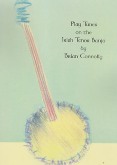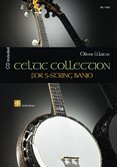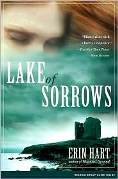Since the 1990s the number of (music) festivals throughout North America and Europe has grown like a snowball. People celebrate local traditions and cultures, and local boards have discovered festivals as a tool to promote tourism and rural development.
 Banjos galore I recently discovered [49],
and here we are again: Craobh Rua's
[2]
[15]
[41]
Brian Connolly offers another banjo tutorial and guide book
to teach the basic techniques for the beginner on the Irish tenor banjo, and
build your repertoire, stamina and confidence when playing and to improve and develop your technical skills, he says.
The first 30 pages are dedicated to the basics:
holding banjo and pick, reading music, playing first notes, major scales, arpeggios.
After a progress check (if you've mastered all this)
comes a couple of songs - "Sally Gardens" to "I'll Tell Me Ma" -
and polka sets with stave notes (without ornamentation), tab, names of the notes placed below, and chords.
Progress check again: playing clearly and fluently including changeover from one tune into another.
Then there's jigs and slides (playing triplets), reels (the supreme discipline),
and, last but not least, hornpipes and mazurkas.
The tunes are recorded in sets of two and at a slower pace on the two accompanying CDs.
Brian stresses again the importance to get the changeover from one tune into the other, so
ending and start are recorded separately.
The volume is dedicated to the memory of the late Dubliners' banjo player Barney McKenna,
[48]
who contributed so much in popularising the tenor banjo in Irish traditional music
and inspired Brian as well, and includes many pictures of banjo players (side effect, you can have a look at their bearing) such as
Angelina Carberry [30],
Éamonn Coyne [33],
Stevie Dunne [49],
Cathal Hayden [39],
Brian McGrath [39],
Mick Moloney [41],
Gerry O'Connor [30],
Damien O'Kane [47],
Enda Scahill [49],
Damaris Woods [49], ...
Banjos galore I recently discovered [49],
and here we are again: Craobh Rua's
[2]
[15]
[41]
Brian Connolly offers another banjo tutorial and guide book
to teach the basic techniques for the beginner on the Irish tenor banjo, and
build your repertoire, stamina and confidence when playing and to improve and develop your technical skills, he says.
The first 30 pages are dedicated to the basics:
holding banjo and pick, reading music, playing first notes, major scales, arpeggios.
After a progress check (if you've mastered all this)
comes a couple of songs - "Sally Gardens" to "I'll Tell Me Ma" -
and polka sets with stave notes (without ornamentation), tab, names of the notes placed below, and chords.
Progress check again: playing clearly and fluently including changeover from one tune into another.
Then there's jigs and slides (playing triplets), reels (the supreme discipline),
and, last but not least, hornpipes and mazurkas.
The tunes are recorded in sets of two and at a slower pace on the two accompanying CDs.
Brian stresses again the importance to get the changeover from one tune into the other, so
ending and start are recorded separately.
The volume is dedicated to the memory of the late Dubliners' banjo player Barney McKenna,
[48]
who contributed so much in popularising the tenor banjo in Irish traditional music
and inspired Brian as well, and includes many pictures of banjo players (side effect, you can have a look at their bearing) such as
Angelina Carberry [30],
Éamonn Coyne [33],
Stevie Dunne [49],
Cathal Hayden [39],
Brian McGrath [39],
Mick Moloney [41],
Gerry O'Connor [30],
Damien O'Kane [47],
Enda Scahill [49],
Damaris Woods [49], ...
Brian Connolly, Play Tunes on the Irish Tenor Banjo - Introductory Repertoire.
2011, ISBN 978-0-9571736- 0-6, pp85, €25 (incl. 2 CDs).
Play Tunes On The Irish Tenor Banjo is available from
Claddagh Records.
 Though a perfect instrument for backing up songs,
the 5-string-banjo is not the most obvious choice for playing Celtic instrumental music,
as a solo melody instrument that is. The question is: can you?
Oliver Waitze, who plays
bluegrass, jazz and swing on guitar, mandolin and banjo, recorded with David Grisman
[27],
authored several flatpicking guitar tutorials and tunebooks, and
owns a guitar shop, the New Acoustic Gallery,
gives an answer. He starts with
an introduction into tune styles of Celtic music (jigs, reels, ...)
and 5-string-banjo techniques (so distinguishing for Bluegrass music)
such as rolls and drones, Scruggs three-finger picking method (best for bluegrass songs),
as well as Bill Keith's melodic style and
Don Reno's single-string style (both suitable for Celtic tunes).
The 52 tunes - with stave notes, tab, chords and fingering - are
mostly of Irish provenience, including several Carolan tunes and polkas
There's also some Scottish reels and the old-time "Ookpik Waltz."
Well, the answer is: Yes, you can!
Though a perfect instrument for backing up songs,
the 5-string-banjo is not the most obvious choice for playing Celtic instrumental music,
as a solo melody instrument that is. The question is: can you?
Oliver Waitze, who plays
bluegrass, jazz and swing on guitar, mandolin and banjo, recorded with David Grisman
[27],
authored several flatpicking guitar tutorials and tunebooks, and
owns a guitar shop, the New Acoustic Gallery,
gives an answer. He starts with
an introduction into tune styles of Celtic music (jigs, reels, ...)
and 5-string-banjo techniques (so distinguishing for Bluegrass music)
such as rolls and drones, Scruggs three-finger picking method (best for bluegrass songs),
as well as Bill Keith's melodic style and
Don Reno's single-string style (both suitable for Celtic tunes).
The 52 tunes - with stave notes, tab, chords and fingering - are
mostly of Irish provenience, including several Carolan tunes and polkas
There's also some Scottish reels and the old-time "Ookpik Waltz."
Well, the answer is: Yes, you can!
Oliver Waitze, Celtic Collection for 5-String Banjo.
Schell Music SM 11056,
2013, ISBN 978-3-86411-056-6, pp159, €36,95 (incl. CD).
 East Galway's Joe Burke
[34]
is an iconic accordion player with a deep knowledge of his land and music.
His skill, style and technique - and his personality himself - have been an inspiration for many
a budding young Irish accordionist. Now 104 tunes have been compiled and recorded by Joe.
72 reels, 23 jigs and 9 hornpipes, featuring traditional and more contemporary
compositions (by the Dwyers, Fahey, O'Brien etc.), including his own "Morning Mist" reel
(which I heard recorded by accordionist James Keane and fiddler Randal Bays [38]),
form a treasure trove of tune settings (says fiddler Charlie Lennon
[46] in the foreword).
On the accompanying CDs every tune is played slowly with variations and ornamentations.
Ornamentation such as rolls and trebles are also indicated in the stave notes.
In the end, the collection is not only suitable for box players but all other instruments as well.
East Galway's Joe Burke
[34]
is an iconic accordion player with a deep knowledge of his land and music.
His skill, style and technique - and his personality himself - have been an inspiration for many
a budding young Irish accordionist. Now 104 tunes have been compiled and recorded by Joe.
72 reels, 23 jigs and 9 hornpipes, featuring traditional and more contemporary
compositions (by the Dwyers, Fahey, O'Brien etc.), including his own "Morning Mist" reel
(which I heard recorded by accordionist James Keane and fiddler Randal Bays [38]),
form a treasure trove of tune settings (says fiddler Charlie Lennon
[46] in the foreword).
On the accompanying CDs every tune is played slowly with variations and ornamentations.
Ornamentation such as rolls and trebles are also indicated in the stave notes.
In the end, the collection is not only suitable for box players but all other instruments as well.
Joe Burke , Traditional Irish Music Collection - 104 Tunes.
2011, ISBN 978-0-95665-170-9, p52, €30 (incl. 3 CDs).
 Doc Rossi is a well-known citternist and guitarist in both traditional and early music.
This is a quick guide for intermediate players
to flatpick traditional Irish dance tunes on the guitar as soon as possible.
Doc Rossi demonstrates ornamentation (mostly hammer-ons and pull-offs, including cranning / popping,
which is a technique used by pipers on the low D or E with lifting off single fingers to achieve a bubbling effect,
here imitated by using a quick succession of one hammer-on and two pull-offs)
to give a basic idea on the "Peacocks Feathers" and the "Fairies" hornpipe.
The 17 tunes include popular hornpipes, jigs and reels with stave notes, tab and chords.
Rossi looks beyond simple three-chord patterns,
and he shows his own tuning to play easily in all important keys without a capo
and with open strings as drone.
It is a small booklet, seemingly, but with a rich content above the average.
The 53 CD tracks feature examplary ornaments, basic rhythms, and each of the 17 tunes played at slow and regular pace.
Doc Rossi is a well-known citternist and guitarist in both traditional and early music.
This is a quick guide for intermediate players
to flatpick traditional Irish dance tunes on the guitar as soon as possible.
Doc Rossi demonstrates ornamentation (mostly hammer-ons and pull-offs, including cranning / popping,
which is a technique used by pipers on the low D or E with lifting off single fingers to achieve a bubbling effect,
here imitated by using a quick succession of one hammer-on and two pull-offs)
to give a basic idea on the "Peacocks Feathers" and the "Fairies" hornpipe.
The 17 tunes include popular hornpipes, jigs and reels with stave notes, tab and chords.
Rossi looks beyond simple three-chord patterns,
and he shows his own tuning to play easily in all important keys without a capo
and with open strings as drone.
It is a small booklet, seemingly, but with a rich content above the average.
The 53 CD tracks feature examplary ornaments, basic rhythms, and each of the 17 tunes played at slow and regular pace.
Doc Rossi, ASAP Irish Guitar - Learn How to Play the Irish Way.
Centerstream,
2011, ISBN 978-1-57424- 288-1, pp32, US$ 19.99 (incl. CD).
Rest my darling, sweetly slumber, while I sing you lullaby ...
Suo Gân (i.e. lullaby; suo = lull, cân = song)
is a well-known Welsh lullaby from an unknown composer,
first printed around 1800, which has been often recorded (especially on Christmas albums).
You might know it from the movie "Empire of the Sun" with Christian Bale lip-synching the song.
Today there are different English translations in use.
Here is sheet music arranged by Tim Knight
[48]
for unison choir with an option to split between upper and lower voices.
Tim Knight, Suo Gan - For Unison Choir with optional upper part.
Tim Knight Music/Spartan Press TKM704,
2012, ISMN 979-0-708106-82-1, pp4, £1.25.

The Danish Tønder festival comes to my mind which has stressed its economic impact on its community since time immorial.[49]
Since being small, seemingly trivial and ephemeral events they are often ignored by local planners and also academics. Chris Gibson & John Connell explore Music Festivals and Regional Development in Australia.
The authors examine the role of festivals in rural small towns in Australia and how they contribute to cultural life and economies in a countryside where wheat and sheep are no longer so important and are gradually being replaced by creative arts, gastronomy and tourism.
Part I discusses general themes:
The folk music revival led to the desire to celebrate the national heritage, ethnic revivalism created a demand for Celtic (and other migrant) events. The expansion of mass tourism then was the spark that triggered countless music festivals.
Several hundred music festivals are taking place outside capital cities annually, almost every rural town in Australia. In 2007, the authors found 288 music festivals in regional areas of the three south-eastern states (Tasmania, Victoria and New South Wales), including more than 30 folk festivals such as the Cygnet, Illawarra, Port Fairy and Tablelands festivals. 75% were operated by non-profit organisations.
They argue that music festivals can be serious components of local economic development and regeneration strategies through visitor expenditure. The 1998 Woodford Folk Festival was reported to have injected about $3 million into the local economy.
Tangible benefits are: increased revenue to local economy, job creation, positive media coverage, increased volunteerism, skills acquisition, subsequent tourism. Intangible benefits are: improved quality of life, community pride, place promotion, ...
Part II provides an in-depth survey of a selection of music festivals and examines how some have become an success.
Parkes in New South Wales had been only known for its radio telescope (The Dish), a vital link in the 1969 Apollo moon landing, but has little other attractions and high unemployment rates. Since 1993, the Parkes Elvis Festival celebrates the birthday of The King, who had never visited Australia at all. It became a huge success against all odds, and the authors show how a new tradition can be constructed by a random concept in a random place.
Outdoor events such as Opera in the Paddock near Inverell in northern New South Wales and the Four Winds Festival near Bermagui on the south coast of NSW offer classical music since 2002 and 1991, respectively.
The whaling town Byron Bay in the far-northeastern corner of New South Wales had been transformed into a countercultural mecca and festival capital, with the East Coast Blues and Roots Festival running since 1990.
Through the major Tamworth Country Music Festival and related tourism, Tamworth in the New England region of New South Wales became known as the place for country music - the self-appointed capital of country music in Australia. Tamworth is anouncing the winners of the Australasian Country Music Awards, and had built museums and memorials - such as a 12 metre high Golden Guitar at the town entrance.
The first Tamworth Country Music Festival had been held in 1973. By 2011, the festival had a 10 day program, 2,400 events, 116 venues and nearly 1,000 artists with around 60,000 daily visitors, making it Australia's largest single music festival and the world's second largest country music festival.
Though Australia (in particular the three south-eastern states Tasmania, Victoria and New South Wales)
is in the focus of Gibson and Connell, the book is relevant for Europe and North America as well.
It is interesting if not essential reading for anybody who's involved with such kind of festivals,
be it economic and tourism organisations or just non-profit promoters looking for
examples, models or even an argumentation aid.

Erin Hart, Lake of Sorrows. 2005.
Photo Credits:
(1ff) Book Covers, (12) Kasey Chambers
(from website/author/publishers);
(11) Tamworth
(by Wikipedia).